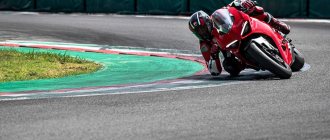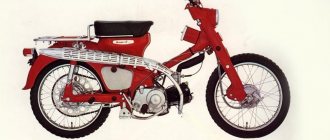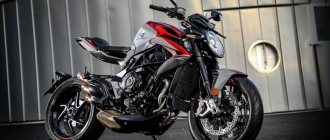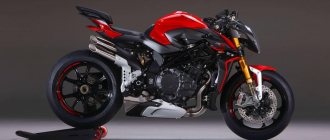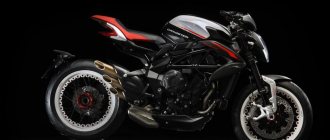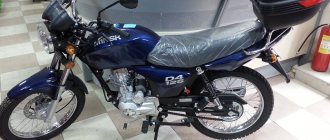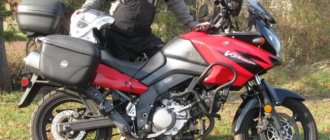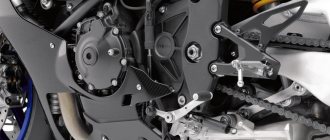MV Agusta Brutale 1000RR 2020
In his last years, the legendary Claudio Castiglioni, together with his brother Gianfranco, were completely in love with the MV Agusta brand, the racing team under this brand and, of course, the motorcycles of this brand. Having taken over MV Agusta, the Castiglioni family not only decided to bring back the glory days of this company, but also to make it a kind of Ferrari of motorcycles.
Actually, with this task, Claudio turned to the Ferrari Engineering design studio owned by Piero Ferrari (a design studio is essentially a design bureau whose tasks include not only the development of components, but also the creation of the external appearance). They, at his request, developed the most advanced and sophisticated 750 cc four-cylinder in-line engine, designed to resurrect MV Agusta. Based on it, maestro Massimo Tamburini would then create the most elegant superbike of all time. That’s what he did, almost from scratch creating the MV Agusta F4 750, which debuted at EICMA 1997 and simply eclipsed other sportbikes with its elegance.
MV Agusta Brutale
However, to Caesar is what is Caesar's, and to the mechanic - what is due to the mechanic. Ferrari Engineering, it must be admitted, has not done much with motorcycle technology. The power they extracted from the short-stroke (diameter 73.8 mm, stroke 45.7 mm) engine was so modest even by the standards of that time that the operating samples had to be given to the racing division of Ducati (at that time Ducati also belonged to Castiglioni as part of the Cagiva Group) in order specialists in motorcycle engines tried to extract from them additional power befitting a legend. The serial F4 750, which saw the world in 1999, produced 126 hp at its peak. The unique beauty of Massimo's design prompted Claudio Castiglioni to release the entire series in limited editions, starting with Serie Oro - the Golden Series.
When the first wave of enthusiasm subsided and the market cooled down, and sales figures remained low, not even reaching 300 units per year, Tamburini was entrusted with the creation of the MV Agusta Brutale 750, a naked version of the F4, which seemed to many a more attractive option. It was also greeted with enthusiasm, but sales of the F4 and Brutale did not recoup the investment; by that time the engine had already established itself as short-lived, and MV Agusta as an unreliable manufacturer that could not cope with after-sales service.
MV Agusta Brutale 1000RR 2020
In 2005, the F4 engine was increased to 998 cc (piston diameter 76 mm, stroke 55 mm, 166 hp), and the Brutale received another 910 cc engine (76 mm, 50.1 mm, 136 hp), retaining the external dimensions of the original 750 cc engine. The problem was that the Brutale frame would no longer accommodate the taller liter engine from the F4. A very strange rejection of the uniformity of the chassis or engines is a striking example of the “creative” approach of the then management of the company.
This issue was worked out only in 2007, changing the frame of the MV Agusta Brutale so that it could accommodate a 1078 cc engine from the F4 CC (piston diameter increased to 79mm, stroke remained 55mm, power - 154 hp). Considering the shortcomings of the project, increasing the cubic capacity was not the best solution, but it made it possible to roll out the next “special editions”, which are sold very expensively and in very small quantities. The regular Brutale was then revived with a 920cc engine introduced in 2011 - a downsized version of the 1090 (73mm bore, 55 stroke, 126bhp) and positioned as an 'entry-level' model.
At this stage, equipping the MV Agusta Brutale with inline fours from the F4 became obviously pointless, because the new 800 cc three turned out to be much more reliable even in its strangled version. By and large, reliability issues only remotely related to power, and were mainly caused by defects in the cooling and lubrication systems. These defects were significant enough to cause melting of the plastic and even composite hood. The MV Agusta factory team, participating in the SBK Series, managed to withdraw from the race more than once or twice due to mechanical failures of the motorcycles.
The latest attempt to improve the engine was made in 2011, when MV Agusta technicians created a short-stroke liter version in which pistons with a diameter of 79 mm (from 1078 cc) moved with an amplitude of 50.9 mm. The short-stroke 998 cc version did not solve the problems with lubrication and cooling, but it spun so well that it produced over 200 horses. The project's chief engineer, Brian Gillen, personally led the redesign, fixed the cooling and lubrication system and turned an expensive unit that was "broken from the factory" into a magnificent engine, on which the new product is based - the MV Agusta Brutale 1000 RR.
This year will be a fateful one for MV Agusta. After all, the Brutale 1000 has finally appeared in its production range - the most energy-equipped serial naked bike in the world.
More than 16,000 visitors to last year's Milan EICMA exhibition voted for the dazzling MV Agusta Brutale 1000 Serie Oro over equally spectacular and coveted rivals (primarily the Ducati Panigale V4 R, BMW S1000RR and Aprilia RSV4 1100 Factory) when determining the most beautiful motorcycle of the show. . Production of the newest Brutale will begin no earlier than the end of August, when Agusta workers return from their summer holidays. However, together with the Russian investor Timur Sardarov, who invested more than 60 million euros in the acquisition of a controlling stake in the MV Agusta holding from Giovanni Castiglioni (the post of president of the company remained with Castiglioni, while Sardarov took the chair of the chairman of the board of directors, and former Ducati techno guru Massimo Bordi was brought in as a consultant ), the Italian brand finally has wind in its sails. Today's Agusta portfolio is replete with an impressive selection of promising models. Moreover, it includes not only the radically redesigned Brutale 1000, the “farewell” F4 Claudio and the retro sportsbike Superveloce 800, which will hit the production line over the next 12 months, but also cars of a more distant future, including a turbocharged “troika” and a whole fleet of electric bikes under the resurrected brand Cagiva. Therefore, need I say what it meant for me personally to be invited to visit the factory on the shores of Lake Varese and become the first person “from the outside”, before whom, by order of Timur Sardarov, the veil of secrecy will be lifted over the pre-production prototype of the “liter” Brutale?..
But first, about the price... The first 300 copies of Brutale 1000 will be included in the limited and, of course, extremely packaged Serie Oro version worth 42,990 euros in Italy (price in Russia - 4,524,930 rubles), the start of deliveries of which is scheduled for October. They will be presented as 2021 models and come in a fiery red color scheme. Production of the “normal” version of the RR will begin later. “However, you can hardly expect the price tag to be below 30,000 euros,” says Agusta technical director (ie chief designer) Brian Gillen, who oversees a team of 21 engineers in Varese working on future Agusta models. " Not alone, of course, but in close collaboration with the Agustov design studio Castiglioni Research Center (CRC), headed by Adrian Morton, headquartered in San Marino. “We're still trying to figure out the specification for the RR to keep it within our target price range,” Gillen continues. “At the same time, both the outstanding energy efficiency and individual key design components (for example, Öhlins adaptive suspensions) will be retained. On the move, both options will be almost identical. But in any case, neither one nor the other will inherit a single detail from the old naked 1090RR Brutale. Even those 20% of units common to the previous model (mainly the crankcase and gearbox) have been significantly modernized.”
The LED headlight with two red strokes is one of the key design elements of the Brutale.
Trying on the MV Agusta Brutale 1000 I was given the opportunity to test the pre-production MV Agusta Brutale 1000 at the Pirelli test site in Vizzola Ticino, which is 40 km from the MV Agusta plant. Still, I am not one of the company’s employees, which means that I am prohibited from riding on the roads on an unregistered motorcycle with a Prova plate instead of a license plate. However, the lion's share of development tests of the new product was carried out at this circuit, so the Brutale Serie Oro will be equipped with magnificent Pirelli Diablo Supercorsa III “donuts” on the assembly line. The wheels, by the way, are also by no means simple - carbon BST with a red streak in the carbon fiber that shows through the varnish in the bright sun. In other words, another brilliant argument that helps justify all those zeros on the price tag.
Carbon wheels from the South African company BST with red thread woven into the carbon fiber look amazing.
No less admirable is the way in which Adrian Morton so subtly and in a modern context reproduced the fundamental elements of the corporate style laid down by Massimo Tamburini in the design of the original Brutale of 2001 (Adrian, by the way, also had a hand in its creation). As a result, the Briton came up with a complete theatrical image, emphasized by the family brutalist quartet of mufflers: Tamburini's wind organ was transformed into a Morton harmonium, but at the same time retained a serious, “adult”, deep voice, albeit muffled for the sake of Euro-4 economic standards. Climbing onto the 845mm saddle was, admittedly, expecting an ergonomic nightmare, but the body position was balanced, without undue stress on the hands and shoulders, even though the widely spaced clip-ons dictate a posture with a noticeable forward lean. And the knees seem to fall into the niches of the 19-liter tank themselves. For such a fast bike, the Brutale is incredibly comfortable.
Virtual instruments are not the most laconic, but at least they do not look overloaded. In addition, the 5-inch diagonal TFT color panel can be customized as desired.
Speed is the goal To say that the liter Brutale is fast is an understatement. He seems like a real beast. So obsessed that the long, 800-meter main straight of the Pirelli proving ground suddenly ceases to be so: I simply did not have enough space to crank the inline-four to the cut-off point in top gear. The most I could see on the perfectly rendered color TFT display (Agusta finally got rid of the cloudy and overloaded instrumentation) was 233 km/h in fourth gear at 13,000 rpm. Although it’s not the speed that surprises at all, but the stability and composure on the asphalt, achieved largely thanks to a specially shaped radiator casing, which appeared after the development team led by Brian Gillen encountered, let’s say, an interesting problem in early tests.
The maximum speed of the MV Agusta Brutale 1000 Serie Oro is no less than 302 km/h
“When we first tested the Brutale prototype, we discovered that we had seriously missed the mark on the driving position,” Brian says, grimacing. — At speeds above 278 km/h, the motorcycle tried to lift up the front wheel and roll over, so we had to completely reconsider the rider’s position and come up with a way to keep the “front” near the ground. So we came to the conclusion that we couldn’t do without wings. True, the naked style implies a minimum of clothing... What to do? Adrian Morton has rethought the design by integrating a pair of winglets into the radiator trim. And the very first blowing in the wind tunnel in Perugia showed that now at a speed of 300 km/h the front wheel is loaded with 15 kg of downforce - and the wheelbarrows in sixth gear have gone into oblivion!”
Alas, I was unable to verify this fact in the conditions of the Pirelli Autodrome. But I will be happy to share my impressions of the absolutely phenomenal acceleration of the Brutale. At the bottom and in the middle, the 998 cm³ engine is elastic and forgiving: it will have no problem maintaining a typical city pace, shifting at a machine-gun pace at 6000 rpm. And as soon as you enter the operational space, it leaps off from its place with the front wheel dancing in the air (the anti-wheelie code on the test motorcycle had not yet been debugged). And despite the fact that you constantly keep your foot on the brake pedal, trying to somehow tame the front, the Brutale tears and rushes so hard that you need to seriously strain to stay astride this guided missile. The two-way quickshifter is superbly tuned, which, however, is not surprising given the many years of experience in using racing technology on MV Agusta production vehicles. The sensor is not configured too sensitively, which is why lightly stroking the lever is not enough to switch - you need to press on it with all your heart. But the power gap is so small that gear changes are completely seamless, both up and down. And yet the character of the engine cannot be called smooth, especially taking into account the noticeable drop in traction at 6500 rpm. But once you cross this mark, there will be a powerful surge again! And she went and went to write the province with all 212 forces, which, due to the use of a balance shaft, does without unnecessarily annoying vibrations - an incredibly exciting experience.
And although the split saddle is covered with tenacious Alcantara, taking into account the frantic accelerations that the MV Agusta is capable of, the support for the “fifth point” is not at all superfluous.
The Art of Making Power Clearly, compressing space with a wildly revving liter and 14,000 rpm shifts isn't the whole story. Brutale also knows how to turn! And, believe me, this fact is almost more impressive than anything else. I had the chance to try a factory-prepared F4 superbike from the time when Leon Camier rode it in WSBK. Let's just say that the Brit had to bend over backwards to make it even remotely competitive. Because the Sportliter handled like a truck - heavy, clumsy and difficult to predict when tilting. And the fact that Camier, together with Gillen’s team of engineers, still achieved certain results was clearly noticeable in individual successful races in 2021. It was these developments that formed the basis of Brutale.
The wire protruding from the blade of the Öhlins NIX fork indicates the presence of an “adaptive”. It is curious that the spring preload on it is adjusted manually with a key, while on the rear Öhlins TTX monoshock this is done remotely.
Now there’s nothing special to talk about handling: for such a powerful and monumental motorcycle, the Brutale is fantastically obedient and understandable. And he is inclined to forgive mistakes. If you suddenly go too fast at the entrance to a bend, you lightly press the front brake lever with your fingers - and the Brutale simply slows down without any intention of getting up and rushing towards the bump stops (or the red and yellow wall of tires framing the Pirelli test circuit). When the assessment of the situation (and the head, in general) is in perfect order, the Agusta will lick the turns, using one gear higher (for example, third instead of second), the Pirelli front tire will actually stick to the asphalt, and the Öhlins suspension will do its job better than the most well-coordinated orchestra. In Sport and Race modes, the injection characteristics are perfectly matched, although in the latter the throttle response is noticeably more aggressive. When moving from a fully closed throttle, the thrust increases not convulsively, as before, but with a confident jump. And this is a sense of control, which, given such a high energy supply, is very, very useful.
The side engine covers are covered with carbon linings.
The main goal that Agusta boss Timur Sardarov set for the engineers can safely be said to have been achieved: the fantastic level of acceleration excites, but does not frighten. Absolutely. Even hard deceleration at the end of the straight from 225 km/h before the closing turn “under the second” does not knock the Brutale off balance. The Brembo Stylema brakes are impressively effective and responsive, and Bosch ABS is careful to ensure that the rear wheel leaves the pavement to a minimum, despite the entire weight of my body being thrown directly onto the front wheel under the onslaught of incredible stopping power. And the introduced engine braking system, coupled with a new slipper clutch, comes in handy here, making gear shifting seamless. All in all, the new Brutale 1000 Serie Oro is a seductive combination of never-before-seen naked performance potential, unparalleled handling and killer looks that clearly speak of being part of the Brutale family.
You can't stop staring at that upturned tail with LED brake light.
Adrian Morton and his team of designers have achieved the almost impossible - reinventing an icon, while maintaining a recognizable design and unique heritage. Moreover, they actually revived the brand's image as a manufacturer of the most attractive and desirable sports motorcycles that money can buy. However, Brian Gillen's design bureau was faced with an equally difficult task of seriously reworking what was essentially a twenty-year-old engine, which led to the fact that the inline-four reached such a high degree of efficiency that it would be very difficult for other manufacturers to reach it. Every step of this work was done with an A plus, which was appreciated by visitors to last year’s Milan EICMA, who recognized the Brutale 1000 as “the most beautiful motorcycle of the show.” And along with them, fans of the brand, who this summer voted with their credit cards for 300 copies of the limited edition Serie Oro.
For effective deceleration, Brembo Stylema four-piston radial monoblocks with 320 mm discs, paired with a Bosch anti-lock braking system, are responsible.
Want it fast? It will be fast for you... The “maximum speed” announced by “Agusta” is more than 300 km/h – this is very, very impressive. And especially for a motorcycle without a fairing! Thanks to the 208 forces that the completely modernized in-line “four” from the F4 sportbike develops at 13,450 rpm. And 115 Nm of thrust at 9300 rpm - also thanks. Moreover, with such a chic operating range (and from peak power to peak torque - as much as 4000 rpm), the Brutale drags everywhere and always. Of course, you can anger him even more, because among the options there is also a titanium exhaust system SC Project, which releases as many as 212 “horses” at 13,600 rpm, but, alas, it does not meet Euro-4 econorms. All these impressive figures come from the new engine, which has a top rev limit of 14,200 rpm and has been designed with a primary focus on reducing internal friction and improving oil system efficiency. Moreover, the motorcycle’s 186 kg dry weight could hardly have been achieved without magnesium covers and titanium fasteners, as well as carbon cladding. But now the Brutale 1000 Serie Oro of the 2020 model year, at least on paper, promises to become a new benchmark in power consumption for the entire class of naked bikes.
The SC Project straight-through titanium exhaust is included in the so-called "race kit". Together with the “reflashed” control unit, it allows you to squeeze 212 hp out of the “liter” engine.
First of all, it will challenge the current leader - the 185 kg Aprilia Tuono V4 1100 Factory, whose V-shaped “four” with its 121 Nm at 9000 rpm is already elegantly placing the Brutale on the tatami with one left. However, when it comes to power, it still has nothing to compete with Agusta: Aprilia has “only” 175 “horses” at 11,000 rpm. In general, everything is relative... It is paradoxical that at a time when other manufacturers are increasing the displacement of their engines to compensate for the consequences of the introduction of regulatory restrictions like Euro-4 (Aprilia and Ducati sportbikes are a good example), MV Agusta has gone in the opposite direction despite the fact that the previous Brutale 1090RR (it was discontinued a couple of years ago) was 1078 cc. “You can get more power in two ways: either by increasing the volume or by raising the speed,” says Gillen. “But if we chose the option of increasing the volume, then to achieve the intended goal we would have to make it more than 1078 “cubes.” Therefore, we decided, on the contrary, to reduce the volume, but at the same time make the engine more revving. The result is an obvious increase in strength.” The cylinder diameter remained the same - 79 mm, but the piston stroke decreased from 55 mm to 50.9 mm, giving 998 cm³. In fact, it reflects those technical solutions that could easily end up on the assembly line along with the next generation of “liter” F4 sportbikes.
Old thinking meets new design... Work on the inline-four began four years ago with the modernization of the engine crankcase of the previous Brutale 1090R, or more precisely, with a major change in the lubrication system so that the engine would not experience oil starvation, regardless of acceleration. And the “litroniced” has no doubt a serious one. After all, when starting from launch control (it is activated by a button on the right remote control), the motorcycle develops overloads of up to 1g: as Gillen says, acceleration to “hundreds” is in 2.9 seconds! And this is on a motorcycle with headlights, a signal and other eco-nozzles. Phew! It’s interesting that the development team spotted the decision to separate the oil reservoir from the engine crankcase on Mike Hailwood’s 1960 MV Agusta champion grand prix MV Agusta! So now the Brutale “in-line” is equipped with a lubrication system with a semi-dry sump and a baffle in the sump, which eliminates the outflow of oil and subsequent oil starvation during overload. “The physics of a motorcycle have essentially remained unchanged since the 1960s,” explains Gillen. “We simply rethought technology from the past in a modern way.”
In the 1960s, Mike Hailwood brought the MV Agusta brand four world titles in the “royal” Grand Prix class and five Tourist Trophy victories.
The short-stroke “four” received seriously modified oil channels, new bearings, as well as forged titanium connecting rods (they are stronger and lighter than the previous milled ones) produced by Oral Engineering from Modena, headed by former technical director of the Ferrari formula team Mauro Forieri. In order to reduce friction losses, Asso pistons with high-carbon steel compression rings are installed. The cylinder head may appear identical to the one on the F4, but the intake ports are different, as are the camshafts with a modified cam profile (higher valve lift, wider valve timing). In addition, the combustion chamber is framed by radially arranged intake and exhaust valves with a diameter of 31.8 mm and 26.5 mm, respectively, which, together with a compression ratio of 13.6:1 (versus 12.8:1 previously), ensure the achievement of the dynamic performance envisaged by Gillen indicators.
The crankshaft, connecting rods and pistons are completely new. But the typically “screamer” character of the engine, of course, remained unchanged. The aluminum plate in the lower right corner of the photo is a partition that separates the oil pan from the crankcase to prevent oil from flowing out when overloads exceed 1g.
Electronics and general parameters One of the key innovations of the Brutale 1000 is “electronic gas” (that is, remote throttle control ride-by-wire), which, together with the introduction of an IMU inertial sensor into the electrical wiring, not only made it possible to change the temperament of the motorcycle on the go, choosing from four modes (spirited Race, moderate Sport, phlegmatic Rain and customizable Custom), but also brought the entire on-board system to a more advanced level. By the way, it includes 8-level traction control, an engine braking system, switchable anti-wheelie, Bosch 9MP+ “angular” anti-lock brake system with a function to prevent rear wheel lift, as well as a two-way quickshifter. True, all this also entailed the need to reconsider suppliers, so the quartet of 50 mm throttle bodies and the lower two-point injection nozzles come from Mikuni, and the upper ones from Magneti Marelli.
The driver's footrests are, of course, adjustable.
However, the traditional partner of the Italians, the manufacturer of electronic components Eldor, is also not forgotten: its stamp marks the ECU control unit, plus a couple of its engineers work from time to time on the Agusta dyno, debugging injection maps. And the binary code is responsible for the operation of the latest generation Öhlins adaptive suspension, automatically selecting settings depending on road conditions and the selected driving mode, and the algorithm in Rain is noticeably different from that in Race. On an inverted fork of the NIX series with stays with a diameter of 43 mm and a stroke of 120 mm, the electronics control exclusively the compression and rebound damping, and on the TTX series monoshock absorber you can remotely adjust the spring preload at the same time. Moreover, the steering damper is also Öhlins branded and is also controlled by “artificial intelligence”: it “clamps” as the speed increases.
The massive single-arm swingarm is borrowed from the F4 RC sportbike and is covered with a metal slider and a carbon casing.
In all other respects, this is a classic MV Agusta chassis with a combined frame made of chrome-molybdenum steel pipes and aluminum castings, where the engine is included in the power structure. The wheelbase is 1415 mm, and the fork angle and offset are 24° and 97 mm, respectively. According to Gillen, the single-arm swingarm with an eccentric for adjusting chain tension was inherited from the F4 RC sports bike without changes - and, as before, it is cast from aluminum rather than magnesium alloy. But the Brembo brakes are at the peak of progress: at the front there are four-piston radial “monoblock” Stylema with 320 mm discs, and at the rear there is a two-piston caliper with a disc with a diameter of 220 mm. Do you know what the engineers had to give up after all the tests? Oddly enough, from a variable-length intake manifold. Why? Because because of it, as they say at MV Agusta, “there was too much torque,” and besides, it made the motorcycle heavier by at least 1.6 kg.
Author: Alan Cathcart Photo: Cal Edge Translation: Black_Helmet
MV Agusta Brutale 1000RR 2021
MV Agusta Brutale 1000RR 2020
Engine
This engine is known for its radial valve arrangement and hemispherical combustion chamber, which provides excellent thermodynamics. Titanium valves and connecting rods reduce inertial energy losses, and much attention has been paid to frictional losses. New camshafts have been designed in conjunction with high-performance intake ports, and the combustion chambers are CNC-machined for a clean finish and precision manufacturing.
To enhance the engine output of the MV Agusta Brutale 1000 RR, each cylinder breathes through a pair of intake funnels of different lengths, and fuel is supplied through two injectors, Mikuni just below the valves and Magneti Marelli above.
Electronics
The engine is controlled by a new high-performance EM2.0 ECU that features four riding modes (Sport, Race, Rain, Custom) combined with a six-axis inertia sensing unit required to operate the eight-speed traction control. Launch control and wheelie control increase rider safety by monitoring the differential speed of both wheels. The on-board electronics suite is significantly more efficient than on any previous MV Agusta model, providing chassis dynamics to match the response of the new engine.
Chassis
For this purpose, active components of Öhlins suspensions with digital control of compression and rebound smoothing are used, the Brembo braking system is equipped with ABS Bosch 9 Plus, which has a Racing mode. The stunning 5-inch TFT display, the heart of the on-board electronics, displays the digital instrument panel and provides access to a variety of settings to tailor the bike to your personal preferences. The control buttons are located on the left remote control, and for entertainment, you can connect a smartphone to the display via Bluetooth. The motorcycle comes standard with active cruise control, and using the MV Ride app on your smartphone, setting up digital functions (including traction control and ABS modes) is much easier. Finally, the new display also provides navigation display.
MV Agusta Brutale 1000RR 2020
The most beautiful motorcycle
The MV Agusta Brutale 1000 RR was announced at EICMA 2021, where the public chose it as the most beautiful motorcycle. Adrian Morton's aggressive design includes some alien touches here and there, but in this case the touches are perfectly balanced and work well with the rest of the design elements.
The completely redesigned 998 cc engine with double overhead camshafts produces excellent power - 208 hp at 13,000 rpm. It is equally important that the peak torque value of 116 Nm is achieved at 11,000 rpm, and a powerful and flat torque plateau begins at 3,500 rpm. The maximum speed is approximately 290 km/h, and an advanced set of electronics ensures that even the average rider can reliably harness all this power. The frame structure retains the classic design - a steel tube cage around the front section of the engine defines the geometry of the front end, and then the tubular structure is attached to massive aluminum "jaws" that wrap around the rear section of the engine and house the single-sided swingarm axle.
Nothing radically new has appeared in the frame design, but extensive research has allowed us to find the optimal steering geometry and weight distribution. The steering angle is very sporty, 23.3 degrees, which, combined with a 30mm traverse offset, results in a trail of 97.2mm.
The compact wheelbase of 141cm and the extensive use of light alloys and composites ensure that the MV Agusta Brutale 1000 RR weighs 186kg, 52 percent of which is at the front. The seat, located at a height of 845mm, is not too low, but thanks to its shape it allows you to easily place both feet on the ground.
As already mentioned, the suspension features top-of-the-line digitally controlled Öhlins components : a fully adjustable 43mm NIX EC fork and a TTX EC rear shock. Two Brembo Stylema monobloc radial brake calipers are mounted on 320mm front discs. The wheels are 120/70-17 at the front and 200/55-17 at the rear.
Despite belonging to the naked class, the Brutale 1000 RR is equipped with aerodynamic elements designed to ensure efficiency and comfort for the rider. The main effect is provided by the wings, which create significant downforce at speeds above 160 km/h.
MV Agusta Brutale 1000RR 2020
The MV Agusta Brutale 1000 RR is beautifully finished and remarkably balanced, feeling extremely solid, tightly built and precisely fitted, with excellent handling at high speeds. The landing and aerodynamics, despite the absence of a windshield, provide good wind protection even at speeds prohibitive for roads, if, of course, you ride in leather and not in travel textiles. At the same time, the Brutale 1000 RR is quite capable of driving comfortably at almost walking speed.
MV Agusta Brutale 1000 RR on the track
On the track, the new MV Agusta Brutale 1000 RR handles superbly, corners with ease and responds to countersteering with precision. The riding position is extremely balanced from an ergonomic point of view, the grips are at the perfect height and width for full control at any speed, the seat and pegs are at the perfect distance and you get used to the bike very quickly. The engine is light and smooth, responding evenly and progressively to the throttle from as early as 2000 rpm, and even in fairly tight corners the bike is effortless even in fourth gear, and the available traction is easily controlled. The engine currently complies with Euro 4 standards, but it is expected that the new firmware will make it Euro 5 compliant. It is also interesting that another model with a three-cylinder 800 cc engine is expected on the same platform.
The new MV Agusta Brutale 1000 RR is an extremely friendly, confident and comfortable sports bike, illustrating that the company's new management knows what they are doing.
With a top speed of 180 mph, the 208 hp Brutale 1000 Serie Oro will be limited to 300 examples.
- Share This Article
- Pin It
- Tumblr
- Talk
MV Agusta could be considered the two-wheeled version of Lamborghini: dreamy, with a financially troubled past, and oh-so-Italian. Under the guidance of second generation company president Giovanni Castiglioni, the manufacturer housed on the banks of Lake Como in Varese—60 miles north of Milan—has gone through a transformation of late thanks to an influx of Russian millions.
As such, they are reorganizing their business model to focus on the highest very end of modern motorcycling. This includes various limited production models, including the stunning MV Agusta Brutale 1000 Serie Oro unveiled to the public at the EICMA Show in Milan on November 4.
Limited to 300 units worldwide, the Brutale 1000 Serie Oro is powered by a 998 cc inline four-cylinder motor that borrows heavily from the company's World Superbike Championship F4 RC racer.
MV Agusta's 208 hp machine. Roberto Tuci
According to MV Agusta, the bike has a top speed of over 180 mph and an incredible 208 hp at 13,450 rpm. The latter increases to 212 hp at 13,600 rpm when the machine is fitted with the SC-Project titanium racing exhaust.
Those horsepower numbers guarantee the model the title of the world's most powerful production naked bike, and also put it near the top of the best superbike numbers currently being produced from competition rivals Ducati and Kawasaki.
MV Agusta has adorned the new Brutale with stunning black, electronically adjustable Öhlins forks and a racing-specific Öhlins TTX36 rear shock absorber, and Brembo Stylema brakes. It also features nearly every electronic aid imaginable with an Inertial Measurement Unit—which governs traction, wheelie, launch, and engine brake control—ABS, and an up/down quick-shift gear change.
An exquisitely dressed naked bike. Photo: Courtesy MV Agusta.
As for the main structure, the motorcycle utilizes a steel trellis frame connected to gold aluminum sideplates, a gold painted swingarm, and ultra-light carbon-fiber wheel rims—the exotic material also extending to the rear bodywork.
Castiglioni has an enormous responsibility on his shoulders as he attempts to steady the MV Agusta ship over what has been decades of troubled waters. However, if machines like this Brutale 1000 Serie Oro are what's in store for the future, we could once again be witnessing the Renaissance of one of Italy's most revered motorcycle brands. Availability and pricing for the United States have yet to be announced.

